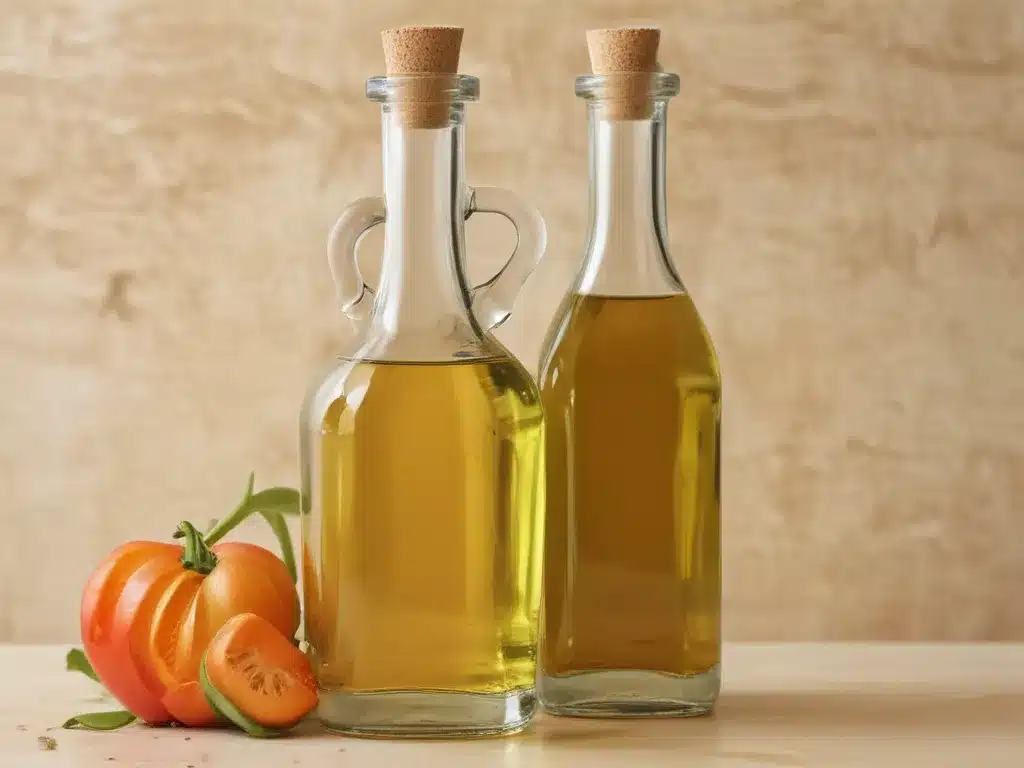What is Vinegar?
Vinegar is a liquid that is produced through the fermentation of ethanol by acetic acid bacteria. The word “vinegar” is derived from the French term “vin aigre,” which means “sour wine.” Vinegar has been used for thousands of years as a food preservative, flavoring agent, and household cleaner.
Vinegar is made by two separate fermentation processes. First, yeast converts the sugars in fruits, grains, or other plant materials into alcohol. Then, acetic acid bacteria convert the alcohol into acetic acid, which gives vinegar its sour taste and pungent aroma.
The most common types of vinegar are:
- White Vinegar: Made from grain-based ethanol, white vinegar has a clear color and a strong, pungent aroma. It is commonly used for cleaning and pickling.
- Apple Cider Vinegar: Made from fermented apple juice, this vinegar has a brownish-golden color and a mild, fruity flavor. It is popular for culinary uses and as a natural remedy.
- Red Wine Vinegar: Produced from red wine, this vinegar has a reddish-brown color and a rich, tangy flavor. It is commonly used in salad dressings and marinades.
- Balsamic Vinegar: This thick, syrupy vinegar is made from grape must (freshly crushed grape juice with skins, seeds, and stems) and aged for several years in wooden barrels. It has a complex, sweet-tart flavor and is often used as a condiment or drizzled over dishes.
Vinegar as a Natural Germ Killer
Vinegar has long been recognized for its antimicrobial properties, making it an effective natural germ killer. The acetic acid present in vinegar is the primary reason for its ability to kill bacteria, viruses, and other microorganisms.
How Does Vinegar Kill Germs?
The acetic acid in vinegar can disrupt the cell membranes of microorganisms, leading to their death. The low pH of vinegar (around 2.4 for white vinegar) also creates an acidic environment that is hostile to many types of bacteria and viruses.
Studies have shown that vinegar is effective against a wide range of pathogens, including:
- Escherichia coli (E. coli)
- Salmonella
- Staphylococcus aureus
- Listeria monocytogenes
- Influenza virus
- Norovirus
Household Applications of Vinegar as a Germ Killer
Vinegar can be used as a natural and eco-friendly alternative to harsh chemical cleaners in various household applications. Here are some common uses of vinegar for disinfecting and sanitizing:
-
Kitchen Cleaning: Vinegar can be used to clean kitchen countertops, cutting boards, and other surfaces. It is particularly effective at removing food stains and killing bacteria like E. coli and Salmonella that can cause foodborne illnesses.
-
Bathroom Cleaning: Vinegar is an excellent cleaner for bathroom surfaces, including toilets, sinks, and tubs. It can help remove soap scum, hard water stains, and mildew while killing germs.
-
Floor Cleaning: A solution of vinegar and water can be used to mop floors, killing bacteria and viruses that may be present.
-
Laundry Sanitizing: Adding vinegar to the rinse cycle of your washing machine can help sanitize clothes and remove stains.
-
Produce Washing: Soaking fresh fruits and vegetables in a vinegar solution can help remove harmful bacteria and pesticide residues.
Precautions and Tips for Using Vinegar as a Germ Killer
While vinegar is generally safe and effective for killing germs, it is important to use it correctly and take certain precautions:
- Dilute vinegar with water: For most cleaning applications, a solution of one part vinegar to one part water is sufficient. Undiluted vinegar can damage some surfaces, especially those made of stone or wood.
- Avoid mixing vinegar with bleach: Mixing vinegar with bleach can produce toxic chlorine gas, which is harmful to inhale.
- Use vinegar on non-porous surfaces: Vinegar may not be as effective on porous surfaces like wood or grout, where germs can penetrate deeper.
- Allow contact time: Let vinegar solutions sit on surfaces for a few minutes to allow the acetic acid to work effectively.
- Rinse after cleaning: Rinse surfaces with clean water after using vinegar to remove any residue or odor.
- Ventilate the area: Vinegar has a strong smell, so ensure proper ventilation when using it for cleaning.
Conclusion
Vinegar is a versatile and natural germ killer that can be used for various cleaning and sanitizing purposes around the home. Its acetic acid content makes it effective against a wide range of bacteria, viruses, and other microorganisms. By incorporating vinegar into your cleaning routine, you can create a safer and more eco-friendly environment while still achieving excellent disinfection results.
If you’re looking for professional cleaning services that prioritize the use of eco-friendly and natural products, consider Adam Cleaning. We offer a range of cleaning services for homes and businesses, utilizing safe and effective cleaning solutions like vinegar to ensure a thorough and sustainable clean.







